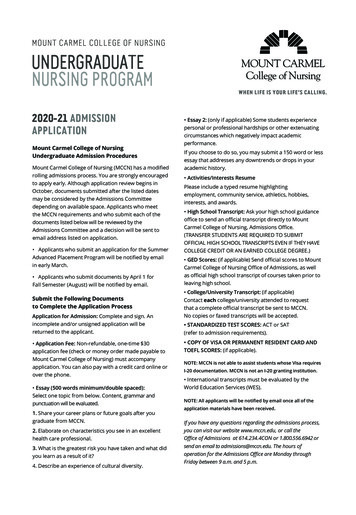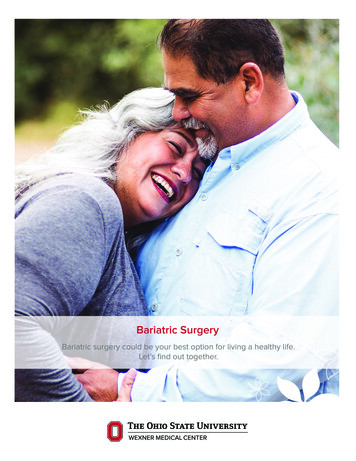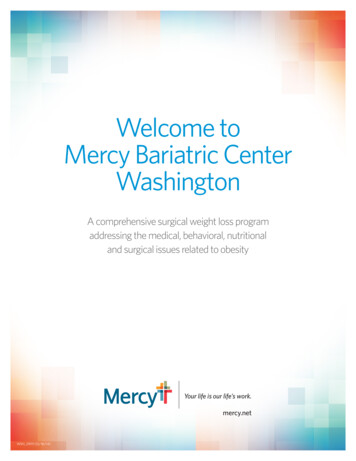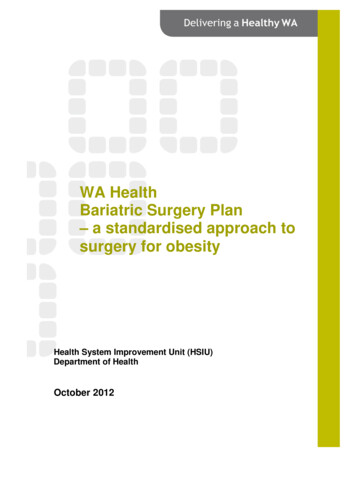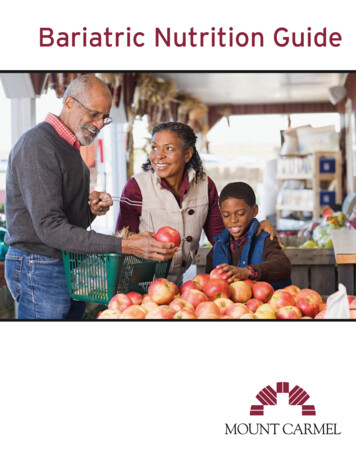
Transcription
Bariatric Nutrition Guide
WelcomeBariatric surgery is an important tool to help you achieveweight loss and improve your health. You will need to followproper dietary guidelines before and after your surgery.To help you prepare, this Bariatric Nutrition Guide coversimportant education about basic nutrition, healthy mealplanning and tips to help you meet your goals. Carefulplanning and changes to your habits will help you besuccessful after surgery.2
Table of ContentsNutrition Basics. 4Nutrition GuidelinesBefore and After Surgery.12Macronutrients and Micronutrients. 4Nutrition Before Surgery.12Carbohydrates. 4Nutrition After Surgery.13Protein. 4Nutrition in the Hospital.13Fat. 5Stages 1 and 2: Guidelines forClear Liquids and Fulls.14Reading Food Labels forHealthy Meal Planning. 7Common Concerns After Surgery.15Healthy Grocery Shopping Tips. 8Recipes for Fulls.16Controlling Food Portions. 9Stage 3: Pureed Diet.19Choosing Well When Eating Out.11Stage 4: Soft Diet.22Stage 5: Regular Bariatric Diet.24Vitamin Supplements.26Tips for Weight Loss.26Fats.26Stocking Your Kitchen.27Resources and Support.28Notes.293
Nutrition BasicsMacronutrientsand MicronutrientsStarchesStarches are used to store energy in plantssuch as potatoes, corn, beans and rice. Starchis also known as a “complex carbohydrate.”Our body needs two types of nutrients: Micronutrients are vitamins and mineralsthat our body needs small amounts ofeach day. Getting the right amount ofmicronutrients is important for goodhealth.FiberFiber is a type of carbohydrate that your bodycan't digest. Fiber is found in plants such asfruits, vegetables, nuts and grains. The mostplentiful source of fiber is whole grains,especially wheat bran.Macronutrients are nutrients our bodyneeds in larger amounts on a dailybasis. Examples of macronutrients arecarbohydrate, protein, fat and water.Read on for more information aboutmacronutrients.Fiber helps our body in many ways:CarbohydratesCarbohydrates are macronutrients thatperform many functions in the body,including providing a key source of energyand assisting with fat metabolism. Weight control Supports gastrointestinal health Lowers blood cholesterol Helps the body absorb nutrientsProteinOur body needs protein to build and maintainbones, muscles, skin and blood. Proteinhelps with the healing process. After bariatricsurgery, most of your calories will come fromprotein.Common sources of carbohydrates includebread, pasta, cereal, grains, fruits, milk andvegetables.The three basic types of carbohydrates aresugars, starches and fibers. Protein provides energy to enable aperson to lose fat and keep muscle duringweight loss. Complete protein foods have 9 out of20 essential amino acids that our bodycannot make on its own. We must getthem from the foods we eat. Examples of complete proteins includemeat, eggs, dairy, fish and soy.SugarsNot all sugars are alike. Natural sugars arefound in foods like fruits and dairy. Sugarscan also be added to foods to improve thetaste or shelf life. Added sugars can quicklyincrease calories without adding nutrients.4
FatFat plays an important role in our diet. There are three main purposes for fat in the body: energystorage, insulation and protection of internal organs.The type of fat you eat is just as important as the amount of fat you eat. Fats can be saturated orunsaturated. Saturated fats are usually solid at room temperature, like bacon grease and butter. Saturated fatshave been linked to high cholesterol, stroke and heart disease. Unsaturated fats are known as "healthy fats." There are two types- monounsaturated andpolyunsaturated. Monounsaturated fats are found in plant-based foods, and are liquid at roomtemperature (like olive and canola oil). Polyunsaturated fats are found in foods such as salmonand walnuts.Eating the right kinds of fats is important to good health. Fat helps the body absorb certainvitamins and provides energy for daily activities. Too much unhealthy fat in the diet can lead toblocked blood vessels, which can cause heart disease and stroke. A high-fat diet can lead to weightgain or lack of weight loss.Check food labels for the type of fat per serving. Listed below are different types of fats andexamples of food sources.Type of FatSaturated FatsLimit saturated fatsto between 10 and 15grams per day.Trans FatAvoid these fats asmuch as possible.Look for "partiallyhydrogenated oils" onthe label.Health EffectsDiets high in saturatedfats can raise yourtotal cholesterol andincrease your risk forheart disease. Checkfood labels for saturatedfat. Avoid deep- fried,processed and "fast"foods.Food Sources Animal fats: beef, pork, lamb, veal, lard,meat fat, high fat lunch meats, bacon,butter, cheese, sour cream, cream cheese,milk and yogurt (whole and 2%), ice cream,cream, half-and-half Tropical oils: coconut, palm, and palmkernel oil Desserts/sweets made with lard, butter ortropical oils Stick margarine, partially hydrogenatedoils, solid shortening, nondairy creamer,cookies, crackers, pastries, doughnuts,microwave popcornTrans fats raise "bad"cholesterol and lowers"good" cholesterol,increasing your riskfor diabetes, stroke andheart disease. Found in many processed foods, such asdonuts, cookies, cakes. Many fried foods atrestaurants are high in trans or saturatedfats5
Type of FatCholesterolMonounsaturatedChoose these healthyfats most often.PolyunsaturatedAnother healthyfat that should beincluded in your dietin moderation.Health EffectsEating large amounts ofhigh-cholesterol foodsmay lead to plaque buildup and narrowing ofblood vessels, especiallyif you have conditionssuch as diabetes or heartdisease.Monounsaturatedfats help reduce badcholesterol and lower therisk of stroke and heartdisease.Polyunsaturated fats arebeneficial to your heartand supply essentialnutrients.Food Sources Meat, egg yolks, shellfish, liver, organmeats, squid, whole milk, cheese, full-fatdairy products Eat a balanced, heart-healthy diet thatincludes whole grains, vegetables, leanmeats, low-fat dairy and fruits Olive, canola (rapeseed), and peanut oils;peanuts, natural nut butters, almonds,cashews, pistachios, pecans, macadamianuts, filberts, avocados, olivesThere are 2 types:Omega-6 fatty acids: Safflwower, corn,soybean, and sunflower oil; pine nuts,seeds; soft or tub margarine; mayonnaise,many store-bought salad dressingsOmega-3 fatty acids: Salmon, trout,herring, anchovies, sardines, mackerel,albacore tuna, fatty fish; ground flaxseed;walnuts, chia seeds6
Reading Food Labels forHealthy Meal PlanningNutrition Facts8 servings per containerReading food labels may seem confusingat times, but is helpful when making foodchoices and planning meals. It is importantto eat a variety of healthy foods to give yourbody the nutrients it needs.Serving size2/3 cup (55 g)Amount per serving230Calories% Daily Value*Serving SizeTotal Fat 8gCheck the label for the serving size. This maynot be the amount you are eating, but it is theamount containing the nutrient values listed.Saturated fat 1g10%5%Trans Fat 0gCaloriesCholesterol 0mg0%While you may not need to count calorieseach day, you should know:Sodium 160mg7%Total Carbohydrate 37g Where your calories are coming from.Dietary Fiber 4g Which foods are high or low in calories.Total Sugars 12g About how many calories you need tomanage your weight. Calories do count.13%14%Includes 10g Added Sugars 20%Protein 3gTotal, Saturatedand Trans FatVitamin D 2mcg10%After surgery, it is important to eat 6 gramsor less of fat per meal.Calcium 260mg20%Iron 8mg45% Excess fat Excess calories.Potassium 235mg Choose unsaturated fats and limitsaturated fats. Do not eat foods that havetrans fats.* The % Daily Value (DV) tells you how much a nutrient in aserving of food contributes to a daily diet. 2,000 calories aday is used for general nutrition advice.Protein6%Carbohydrates, Sugars,and Dietary FiberYour goal is 65 to 75 grams of protein perday. Protein is needed to maintain yourmuscle mass. Eating protein with eachmeal helps reduce hunger between meals.Lean protein foods with low saturated fatcontent are best for weight and cholesterolmanagement. Meat, fish and poultry eachhave about 7 grams of protein per ounce.Low-fat dairy, eggs and legumes are also goodsources of protein.Keep sugars to 6 grams or less per meal.This helps you avoid eating too many calories.Round out your meals with carbohydratesthat contain dietary fiber, such as wholegrains. Fiber adds nutrients, helps preventconstipation and control cholesterol levels.7
Healthy GroceryShopping TipsLearning how to buy the right foods is animportant step in losing weight. Having theright foods on hand will help you make goodchoices. Make a list and follow these tips tochoose healthy and delicious foods at yournext trip to the grocery store. Plan your menus for the week. Check ads for sale items and clip coupons. Plan to buy a variety of items to providebalanced nutrition. Make sure your meal plan includes wholegrains, fruits, vegetables, dairy products,protein and fats. Frozen fruits and veggies are a goodoption as well. Choose fruits packed in water or theirown juices (no added sugar). Chose vegetables canned without salt. Pick colorful vegetables to get a variety ofnutrients, such as red, orange and green.and vegetables canned without salt.Dairy ProductsDairy products provide calcium, riboflavin,vitamins A and D and are also a source ofprotein. Plan to buy a variety of products. Stock up on skim milk, fat-free yogurt andlow-fat (2%) cheeses that are natural, forexample: Cheddar, Swiss, Colby, Ricotta,Provolone, Mozzarella. Avoid processedcheese. Read nutrition labels for fat and sugarcontent.GrainsWhole wheat flour and whole grains providefiber, vitamins and minerals. Check the label to see that 100% wholewheat flour is the first ingredient. Choose bread and crackers that are wholegrain and high in fiber (5g fiber or moreper serving). Meat and Protein SourcesYou can choose a variety of protein sources tomeet the required intake of 65 to 75 grams perday.Brown rice has the most nutrients and ishigh in fiber too. Select lean meats to add protein, iron andzinc. Good choices include eye round, topround, top sirloin and flank steak cuts forbeef and loin cut for pork. Try soy-based meat substitutes, such astofu. Fruits and VegetablesInclude fish, dry beans, eggs and nuts. Fruits and vegetables provide vitamins,antioxidants, fiber and are low in fat.Purchase skinless chicken or remove theskin before cooking. Healthy fish options include orangeroughy, talapia, tuna, cod, haddock andsalmon. Frozen fish is a good option andjust as nutritious as fresh. Canned fishpacked in water instead of oil is a lowercalorie choice. Choose pasta and cereals that are wholegrain. Read labels for sugar and fat content. Cereal must have more fiber than sugar. Look for in-season produce. It will havethe best flavor and save you money. Long-lasting produce: carrots, apples,grapefruit, melons and oranges.8
Controlling Food PortionsFatsControlling food portions are an importantpart of good health and weight management.If the amount you eat is larger than the singleserving size, you are consuming more caloriesthan what is shown on the food label. Eatingsmaller portions of a variety of nutritiousfoods will help you meet your goals.Both polyunsaturated andmonounsaturated fats may help loweryour blood cholesterol level when youuse them in place of saturated andtrans fats. When shopping choose: Vegetable oils and margarines withliquid vegetable oil as the first listedingredient. Examples are canola,corn, olive, peanut, safflower,sesame, soybean and sunfloweroils. Soft spreads or liquid/tubmargarines low in saturated fatsand trans fats. Reduced-fat and no-fat saladdressings and mayonnaise. Foods including fatty fish (suchas salmon, mackerel, herring andtrout), avocados, peanut butter,and many nuts and seeds. Daily Portion Control TipsUse small plates (6"), bowls, glasses andserving utensils to give the appearance ofmore food.Avoid trans fats as much aspossible. Trans fats are found infried foods, processed foods, snacksand baked goods.9 Remember to eat protein first, thenvegetables, then a carbohydrate choice. Use a scale as well as measuring cups andspoons for proper portion control. Every lunch and dinner should includefresh, frozen or canned vegetables. Eat slowly and enjoy your meals. It cantake 20 minutes for your brain to get themessage that your stomach is full. Focus on what you are eating. Avoideating while you are watching TV ordoing other activities. Avoid buying foods in bulk. If you buylarge food packages, divide a bargain-sizebag into single portion servings. If you buy frozen meals, choose mealswith portion control built in. Take the serving amount you will eat andput it on a plate. Do not eat right fromthe package.
Sizing Up PortionsMany portions are larger than you think.Make sure to check food labels to see howmany servings are in a container. Use thefollowing guide to quickly measure singleportion sizes.ProteinsMeatCottage CheeseCheeseNutsBeansThe palm of your handis good for estimatingthe size of your meat orfish portion (3 oz.).3 oz.½ cup1 oz.½ oz. approximately½ cupYour fist is good forestimating about one cup(also it is the right size for abaked potato).CarbohydratesFruits½ tennis ball or ½ cupDairy½ cup milk, yogurtGrains½ cup cereal½ slice bread⅓ cup cooked rice⅓ cup cooked pastaThe cup of yourhand or the sizeof a tennis ball isa good estimatefor your serving offruit (like an appleor orange).Fats1 tsp. margarine/oil1 Tbsp. peanut butter10
Choosing WellWhen Eating OutEating out can be a challenge when youare trying to eat in a healthful way. Whendining out, you must be aware of the choicesyou make and follow the same nutritionalguidelines as you would at home. Many placesoffer low-fat, low-calorie options, or willprepare food to your request. Watch yourportion sizes, too.When eating out, it is important to rememberit is not about the food. Eat slowly and enjoyyour meal, but focus on being together andsocializing with friends or family. Use thesetips to ensure that you are eating healthfully: Order foods that are: baked, steamed,broiled, grilled, roasted, or stir-fried tolessen the fat and calories. Choose places that you know offera healthy menu or will cater to yourrequests. Steer clear of buffets — portion control, aswell as self control, is hard at such places. Manage your portion sizes:Salads are a great choice, but be carefulabout what you put on them. Limitcheese, bacon and croutons. Choosemostly vegetables, and salads made withrich dark greens like spinach or romainerather than iceberg lettuce. Always ask for salad dressings on theside. To cut down on calories and fat, trydipping your fork into the dressing andthen spearing the lettuce. Instead of french fries or other high-fatside dishes, choose a baked potato, sidesalad, steamed vegetables or fresh fruit. Ask to have foods cooked without butteror margarine. Don’t be afraid to ask for items that arenot on the menu. Many restaurants willmake special dishes or substitute one itemfor another. Go easy on the alcohol. Wine or lightbeer are the best choices. If you are morethan six months past surgery, drink only 1drink then switch to water.There are many helpful resourcesfor nutrition facts, food tracking andfitness. Try different websites and appsand see what works best for you.— Ask for a container before you begineating. Split the portion in thirds orhalf to take home. You’ll be less likelyto overeat when you pack it away first.Be sure to refrigerate the food within2 hours. Avoid dishes with gravy, cream sauce,cheese or sour cream. Be aware of extras. Sandwich toppingssuch as cheese or bacon, or sauces suchas mayonnaise, will add many calories.Ask for extra lettuce, tomato, onions andmustard.11 Calorieking.com Myfitnesspal.com MyPlate Calorie Counter Start Simple with MyPlate
Nutrition GuidelinesBefore and After SurgeryOne of the keys to successful gastric bypasssurgery is preparation. These instructionswill help you prepare for surgery and thedietary stages you will go through aftersurgery. Practicing healthy lifestyle andnutrition habits before surgery will help yoube successful.CaffeineThe bariatric dietitian will register you for aclass about post-surgery nutrition. This classwill take place 1 or 2 weeks after surgery. Youwill be notified of the date for this class at thetime of your surgery. Do not have any caffeine for the 3 daysbefore your surgery. Do not have any caffeine for 6 weeks aftersurgery. You will continue to limit decaffeinatedand regular caffeinated products to 2 (8oz.) cups a day.Carbonated Beverages Nutrition Before SurgeryDo not drink carbonated beverages for6 months after surgery. This can causeexcess gas, bloating or irritation.Alcoholic BeveragesIt is very important that you fully committo eating a well-balanced meal plan for the 2weeks before your surgery. Sometimes referred to as the "lean and green"plan, this will help your body tolerate surgerybetter and decrease the size of your liver.Do not drink alcoholic beverages for 6months after surgery. Alcohol provides“empty calories” and should be consumedwith caution.Daily Goals of "Lean and Green": Eat only lean meats, vegetables, fruits, and whole grains. Do not eat processedor greasy foods. Eliminate simple sugars. Eat between 65 to 75 grams of protein each day. Drink 64 ounces of water.12
Nutrition After SurgeryHelpful TipsBefore Surgery Practice not drinking with yourmeals. Instead take sips of fluidsthroughout the day.STAGE 1 Day of surgery: Ice chips and clear liquid dietPractice eating slowly, taking verysmall bites. Meals should take 20 to30 minutes to consume. Chewing food completely beforeswallowing. Put down your eating utensilbetween bites. Consider using a baby-sizedutensil. Discuss diet changes with thepeople that live with you. It ishelpful if they try not to bringunhealthy foods into the homeand focus on improving their owneating habits. As you recover from surgery, your diet willgradually progress through the followingstages:STAGE 2 Day after surgery through the end of week 2(14 days): Fulls (also called full liquid diet)STAGE 3 Weeks 3 and 4: Pureed dietSTAGE 4 Week 5: Soft dietSTAGE 5 Week 6 and beyond: Bariatric regular dietNutrition in the HospitalStart keeping a food diary. Writedown your foods and drinks, alongwith portion sizes. You can alsotrack your intake using an app orwebsite.You will be given ice chips and clear liquidsafter recovering from anesthesia. You willget clear liquids for dinner and breakfast.You may drink as much as you want of theseliquids.You will be given additional preoperative instructions to prepareyour surgery. Call the Mount CarmelBariatric Program if you havequestions.13 You will receive intravenous (IV) fluidsafter surgery to make sure you stay wellhydrated. Eat a maximum of ¼ cup for each mealwhile you are in the hospital. Do not tryto consume more. This is the time for youto begin to pay attention to your body’sfeeling of fullness.
Stages 1 and 2:Guidelines for ClearLiquids and FullsClears — Use Between MealsDuring the first 2 weeks after surgery, yourdiet will be limited to allow your pouch toheal. Review this list and make sure to haveallowed items available to eat at home. Do noteat anything that is not on the list.Protein IntakeYour protein intake goal is 65 to 75 gramsper day (11 - 13 grams per meal). It is very important that you reach andmaintain this level of protein.Protein Supplements Plan to put protein powder in most foodsand beverages to help you reach your goal. The supplement that you buy should be awhey or soy protein ISOLATE. We recommend unflavored and flavoredprotein powders. There are also protein waters and readyto-drink protein shakes that can help youreach your protein goals. You may buy protein supplements onlinebut they can also be purchased at mostgrocery stores and major retailers.Water Canned broth or bouillon Gatorade Zero Decaffeinated coffee or tea(NO cream or milk added) Crystal Light Sugar-free Kool-Aid Sugar-free Lemonade without pulp Sugar-free Jell-O Sugar-free Popsicles Isopure protein water (buy at health foodstore)Fulls — use at meal times(Eat ¼ to ½ cup meals 6 times per day for14 days.)An acceptable protein powder shouldcontain between 15-20 grams of proteinper scoop and little or no fat or sugar. Fluid IntakeYour goal for fluid intake is 64 ounces(8 cups) per day. Cottage cheese – small curd, low-fat Skim or 1% milk No-sugar added pudding No-sugar added fudgsicles Sugar-free, fat-free yogurt Low-fat cream soups — strained (creamof mushroom, chicken, celery, tomato,potato) Sugar-free cooked cereals — oatmeal,cream of wheat, cream of rice or grits Peanut butter (for recipes ONLY) Hot cocoa mix (sugar-free) or CarnationInstant Breakfast Light Start powder (nosugar added) Nonfat dry milk powder Do not use a straw when you drink fluids. Evaporated skim milk Stop drinking fluids 30 minutes beforea meal and do not drink for 30 minutesafter a meal. Liquid egg whites, pasteurized(do not cook)14
Vitamins and MineralsCommon ConcernsAfter SurgeryOne Week After Surgery: Take one chewable multivitamin withiron per day with food. Check that theproduct contains carbonyl iron or ferrousgluconate.LactoseLactose intolerance causes gas, bloating anddiarrhea. If you are lactose intolerant, tryusing lactose free milk or chewable lactaseenzyme tablets before consuming milk ordairy products. You may also try low-sugar/low-fat non-dairy substitutes.There are also multiple bariatric specificmultivitamins that can provide all of thevitamins and minerals you need aftersurgery.Dumping SyndromeSample Menu forFulls Diet StageDumping syndrome is caused by eating ordrinking concentrated sources of sugar.Sugar cannot be broken down in your newsmall stomach and can cause large amountsof fluid to enter your intestine. This canresult in facial flushing, increased heartrate, nausea, vomiting, and/or diarrhea. Westrongly recommend you avoid high sugar,empty calorie foods to promote weight loss.Do not eat more than 6 grams of sugar permeal to help avoid dumping syndrome.The following is a sample menu to followfor the first 2 weeks after surgery. You mayconsume ANY of the foods/supplements/liquids on the full liquid list. Do not limityourself to these foods only. Times areexamples also.8:00 a.m.11:00 a.m.1:00 p.m.4:00 p.m.7:00 p.m.10:00 p.m.¼ – ½ cup fulls recipe¼ – ½ cup strained creamsoup with protein powder¼ – ½ cup sugar-freepudding with proteinpowder¼ – ½ cup no sugar addedyogurt with protein powder¼ – ½ cup cooked cerealwith protein powder¼ – ½ cup fulls recipeHair LossHair loss or thinning is a common sideeffect of rapid weight loss. Protein isimportant in helping to prevent hair loss,but you can eat adequate amounts ofprotein and still have some hair loss. Thishair loss often occurs 2 to 4 months aftersurgery. Help prevent hair loss by eatingadequate protein and taking the vitamin/mineral supplements as recommended.FatHigh-fat foods can cause diarrhea becauseyour body does not absorb fat as well aftersurgery. High-fat foods also contain a lot ofcalories which is not beneficial for weightloss.15
freezing these recipes for a frozen treat. Trysubstituting Isopure water for some of theclear beverages for added protein.Recipes for FullsThese recipes are for full liquid drinks that arehigh in protein. They will be especially helpfulfor the first several weeks after surgery, butyou may choose to include one high proteinitem each day on an ongoing basis.Recipes that have berries with very small seedsshould not be a problem for you.Make sure that these are well blended and thatno large pieces remain.Use a sugar-free protein powder supplementfor the following recipes. You may tryBANANA SPLIT½ cup skim milk1 scoop chocolate protein powder4” banana, ripe⅛ cup pineapple, canned, packed in juice3 strawberries, frozen, no added sugarCARNATION INSTANTBREAKFAST SMOOTHIE1/4 cup orange juice, 100%½ cup skim milk1 package Carnation Instant Breakfast , noadded sugar, vanilla1 scoop vanilla protein powder4 ice cubesPut all ingredients into blender. Blend on highfor 45 seconds. Makes one cup.Put all ingredients into blender. Blend on highfor 45 seconds. Makes one cup.Nutrition information per ½ cup:Calories 116Protein12 gFat1gSodium 52 mgNutrition information per ½ cup:Calories 120Protein14 gFat0gSodium 100 mgAPPLE SHAKE½ cup skim milk¼ cup light yogurt, no added sugar, vanilla¼ cup applesauce, no added sugar1 scoop vanilla protein powder4” banana, ripepinch cinnamonpinch nutmeg2 drops vanilla extractPROTEIN POWER CRYSTAL LIGHT ½ cup prepared Crystal Light1 scoop unflavored protein powder2 tablespoons Cool Whip Light 4 ice cubesPut all ingredients into blender. Blend on highfor 45 seconds. Makes one cup.Put all ingredients into blender. Blend on highfor 45 seconds. Makes one cup.Nutrition information per ½ cup:Calories 62Protein10 gFat0gSodium 20 mgNutrition information per ½ cup:Calories 100Protein12 gFat1gSodium 64 mg16
BREAKFAST BOOST PLUS½ cup orange juice, 100%¼ cup yogurt, vanilla, light, no added sugar4 strawberries, frozen, no added sugar3 peaches, frozen, no added sugar2 scoops unflavored protein powderPROTEIN POWERPINEAPPLE SMOOTHIE⅔ cup pineapple juice 100%½ cup cottage cheese, low-fat1 scoop vanilla protein powderPut all ingredients into blender. Blend onhigh for 45 seconds. Makes one cup.Put all ingredients into blender. Blend onhigh for 45 seconds. Makes one cup.Nutrition information per ½ cup:Calories 134Protein18 gFat1gSodium 250 mgNutrition information per ½ cup:Calories 160Protein20 gFat0gSodium 62 mgPROTEIN POWER ICED CAFÉ VIENNA1 cup skim milk1 scoop unflavored protein powder1⅓ Tbsp. General Foods InternationalCoffee , Café Vienna, sugar-free6 - 7 ice cubesEGGNOG½ cup skim milk2 scoops vanilla protein powder½ tsp allspice¼ cup yogurt, vanilla, light, no added sugar½ graham cracker (2 small squares)4 ice cubesPut all ingredients into blender. Blend onhigh for 45 seconds. Makes one cup.Put all ingredients into blender. Blend onhigh for 45 seconds. Makes one cup.Nutrition information per ½ cup:Calories 110Protein14 gFat1gSodium 116 mgNutrition information per ½ cup:Calories 166Protein22 gFat0gSodium 130 mgCHOCOLATE PEANUT BUTTER CUP½ cup skim milk1 scoop chocolate protein powder1 tsp peanut butter, creamy4 ice cubesFRUIT FREEZE½ cup skim milk5 strawberries¼ banana, ripe2 peaches, frozen, no added sugar¼ cup pineapple, canned, packed in juice1 scoop unflavored protein powderPut all ingredients into blender. Blend onhigh for 45 seconds. Makes one cup.Nutrition information per ½ cup:Calories 88Protein12 gFat2gSodium 64 mgPut all ingredients into blender. Blend onhigh for 45 seconds. Makes one cup.Nutrition information per ½ cup:Calories 108Protein12 gFat0gSodium 54 mg17
KEY LIME PIE6 ounces sugar-free/fat-free key lime pie yogurt⅛ cup skim milk1 tsp gelatin, lime, sugar-free1 scoop unflavored protein powder½ graham cracker (2 small squares)Put all ingredients into blender. Blend on highfor 45 seconds. Makes one cup.Nutrition information per ½ cup:Calories 116Protein14 gFat0gSodium 90 mgHot DrinksPROTEIN POWER CAFÉ VIENNA1 cup skim milk1 scoop unflavored protein powder1⅓ Tbsp. General Foods International Coffee Café Vienna, sugar-freeHeat milk to desired temperature. Put allingredients into blender. Blend on low for 20seconds. Makes one serving.Alternates: Use General Foods InternationalCoffees French Vanilla Café and SwissMocha, sugar-free.Nutrition information per ¼ cup:Calories 106Protein14 gFat0gSodium 118 mgPROTEIN POWER PLUS HOT COCOA1 cup skim milk1 packet hot cocoa, no sugar added2 scoops chocolate or unflavored proteinpowderHeat milk to desired temperature. Put allingredients into blender. Blend on low for 45seconds. Makes one cup.Nutrition information per ½ cup:Calories 166Protein26 gFat2gSodium 252 mg18
Stage 3: Pureed DietBeginning at post-op week 3, you willstart eating pureed foods. Pureed foods areblended with liquids (such as fat-free milk,clear broths, fat-free gravies or juice) untilit is a smooth texture with a consistency ofmashed potatoes. You can continue to includefoods from the full liquid diet throughout thisstage. Eat slowly. You should be taking 20 to 30minutes to eat a ¼ to ½ cup meal. Eat 6 small meals per day. Each mealshould be no more than ½ cup. A food processor works best to pureefoods. If you don’t have one, use a goodblender instead. Add new foods one at a time so if youhave any intolerance, you will know whatcaused it.Important Tips for a Pureed Diet: Remember to eat protein first at eachmeal. You need a minimum of 65 to 75grams of protein each day. You may use stage 1 or stage 2 baby foods.Avoid stage 3 baby food or any foods withchunks or pieces. Continue to include 8 cups of fluid eachday. Stop drinking fluids 30 minutesbefore a meal and do not drink until 30minutes after a meal. You may season foods to taste but a
Bariatric surgery is an important tool to help you achieve weight loss and improve your health. You will need to follow proper dietary guidelines before and after your surgery. To help you prepare, this Bariatric Nutrition Guide covers important education about basic nutrition, healthy meal planning and tips to help you meet your goals. Careful
